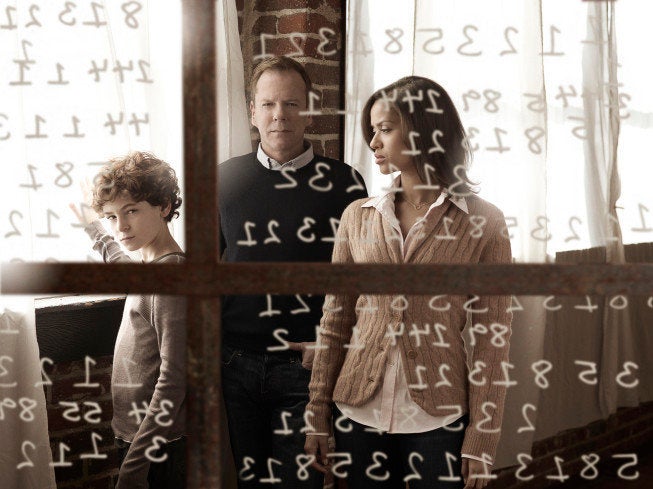
The new Fox TV series Touch, starring Kiefer Sutherland, has as one of its central characters a mathematically gifted, autistic, 11-year-old child Jake, played by David Mazouz. How accurate is the portrayal of mathematics in the show? Based on the first episode, the answer is, "Not very." (The caveat is, it doesn't really matter.)
The first number we encounter, by way of Jake's disembodied voice (he does not speak, so we only hear him as a thought-track) is the golden ratio, approximately 1.618. Thematically, that's good, since that number does occur a lot in nature, often by way of its closely associated Fibonacci sequence. Which makes it all the more perplexing that, midway through the first episode, we have Danny Glover's character repeating a series of oft-recycled falsehoods about the Fibonacci sequence.
He begins by saying that it was discovered by the twelfth-century mathematician Fibonacci, which is not true. Fibonacci (who was in fact a thirteenth-century mathematician, and who was not given that nickname until the 19th century) simply included in a book he wrote, an ancient arithmetic problem that yields those numbers when you solve it. There is no evidence that he ever investigated the sequence. Besides, most of the sequence's interesting mathematical properties and its connections to the natural world were not discovered until many centuries later.
Though there are many fascinating examples of the occurrence of the Fibonacci sequence in the natural world, the three that Glover cites are all wrong: that the sequence can be found in the curve of a wave, in the spiral of a shell, and in the segments of a pineapple.
Almost certainly, the writer looked at one of many popular math books that are available, or consulted some of the even greater number of Fibonacci-related websites, where such false claims are repeated with uncritical regularity. (Ironically, Danny Glover was the host for the PBS math documentary series Life by the Numbers, that was first broadcast in 1998. He got the math right then. He should have done. I helped write the script.)
It would have been easy to get the math right in Touch. On the other hand, taken literally, the portrayal of the application of mathematics to the world by the young Jake is so way-over-the-top fictitious that inaccuracy in specific details does not adversely affect the storyline.
In this respect, Touch is very different from the previous television series in which one of the main characters was a mathematician, the CBS crime series NUMB3RS, on which I was an adviser for the first three seasons. There, the intention was always to portray mathematics accurately, and the producers went to great lengths to ensure that outcome.
In contrast, it's as a metaphor for the role of numbers and mathematics in today's world that Touch comes into its own, and does so brilliantly.
As the first episode opens, we hear Jake say, "Patterns are hidden in plain site. You just have to know where to look." That line could have been taken right out of my 1996 book Mathematics: The Science of Patterns. (Don't worry, Fox lawyers; it wasn't.)
To most people, mathematicians spend most of their time scribbling obscure looking symbols into notebooks or on blackboards -- or, in TV and movie portrayals, on windows and bathroom mirrors. But to the mathematician, those symbols are what is required to describe those hidden patterns in the world around us, in much the same way that the equally obscure looking symbols of musical notation capture the melodious patterns of music.
Later on in the first episode, we hear Danny Glover's character say much the same thing, but with a focus on human connectivity:
"The universe is made of precise ratios and patterns, a quantum entanglement of cause and effect where everyone reflects on each other... Your son sees everything -- the past, present, future -- he sees how it's all connected."
The fact is, Touch is not a math-based TV series. It's about human connectivity.
It is just possible that there is an underlying quantum-level connectivity, as Glover claims, which gives rise to human connections, but if so that is for scientists centuries hence to figure out.
But what is the case, today, is that mathematics lies beneath all of the transportation and communications technologies that really have created a world where many of us -- and very soon all of us -- will be (potentially) connected, and can affect each others lives, instantly.
Not only has mathematics given us that world, with radio and TV, jet aircraft, cell phones, the Internet, the social web, etc., it is mathematics that enables us to understand it. In that sense, Jake is a metaphorical representative of all mathematicians -- the ones who really do possess the power to see -- and to create -- those connections.
"You're telling me my son can predict the future," Sutherland replies incredulously when he hears Glover's words.
"No I'm telling you it's a roadmap," comes the reply.
That's not literally true. Mathematics provides roadmaps for the physical universe, but not for the social world. If you want a literal answer, Glover would have had to say "It's a contour map."
Touch stretches the power of mathematics to understand and to accurately predict beyond the physical world, to the lives of individual people, and math doesn't do that. But that's how big-theme fiction works, by taking sweeping ideas and shrinking them down to a personal level. (Think of all those famous Russian novels!)
Whether the series creators and writers set out to create, by way of Jake, a metaphor for the role of mathematics in the modern (and to some extent the ancient) world of human connectivity, I have no idea. At some level, they must have. Regardless of their intent, however, if the first episode is anything to go by, they have done so superbly.
How well? I could base an entire college level math course just on Touch's pilot episode. And if the series lives up to the promise of the pilot, I probably will.
